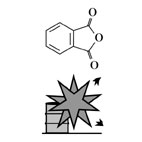| Case Name |
Explosion caused due to leak of niter as a heating medium in the distillation drum at a phthalic anhydride manufacturing plant |
| Pictograph |

|
| Date |
October 19, 1966 |
| Place |
Omuta,Fukuoka, Japan |
| Location |
Chemical factory |
| Overview |
An explosion occurred when vacuum distillation was carried out using niter as a heating medium in a phthalic anhydride manufacturing plant. The niter leaked and reacted with the solution in the vessel. The hazardous properties of niter are sufficiently known. The risk of using niter should have been known as general chemical knowledge. |
| Incident |
The No.1 distillation drum exploded during purification of phthalic anhydride in a vacuum distillation process. It was crushed, and fragments of the vessel were scattered in a 100 m radius, and the plant was destroyed. |
| Processing |
Manufacture |
| Individual Process |
Distillation |
| Substance |
Phthalic anhydride, Fig2 |
| Type of Accident |
Explosion, fire |
| Sequence |
03:10 on October 19th, 1966: A batch distillation vessel for phthalic anhydride exploded. In this distillation process, impurity-free phthalic anhydride was fed from the pretreatment, and then distilled under reduced pressure of 30 mmHg for about 40 hours. At the accident, there were still five hours left. Four distillation vessels were operating, and all of them had jackets with niter as the heat medium for heating at about 300 °C. The temperature of phthalic acid was about 180 °C, and the niter itself was heated with a fuel oil furnace.
Niter; A molten nitrate salt mixture of KNO3, NaNO3, and NaNO2, etc., which can be used as a heat transfer medium up to 538 °C. |
| Cause |
The following is presumed;
(1) The explosion occurred at the distillation drum alone, and it was not induced by another explosion at other equipment or piping.
(2) There is little possibility of a combustible gas-air mixture was generated by air leakage, because a reduced pressure of 30 mmHg could be maintained, and there was no mark of an internal explosion in either the distillation drums or condensers.
(3) The possibility of an explosive reaction caused by a small amount of maleic anhydride as a contaminant and sodium hydroxide used for pretreatment is small, taking into account their boiling points.
(4) There are many reported cases of explosion caused by the reaction of leaked niter due to a defect in a distillation drum.
Based on the above, it is considered that niter leaked into the drum and reacted with phthalic anhydride or impurities. |
| Countermeasures |
Never use an oxidizer such as niter as a heating medium for an organic substance. Sufficient maintenance should be carried out when it must be used. |
| Knowledge Comment |
Special care should be taken when using niter as a heating medium for organic substances, because a strong exothermic reaction will occur if it contacts the organic substance on leaking inside. |
| Background |
Due to imperfect maintenance, niter leaked inside. Moreover, the dangers of the niter might not be well known to operators.
Niter is widely used for its heat transfer properties in the temperature range of 149-538 °C as a heat transfer medium. It originally has a strong acid nature, and it is known that a strong explosion is caused when it contacts with an organic substance in a melted condition. |
| Reason for Adding to DB |
Example of explosion caused due to lack of basic knowledge on material hazards |
| Scenario |
| Primary Scenario
|
Insufficient Analysis or Research, Insufficient Practice, Insufficient Image of Abnormal Situation, Poor Value Perception, Poor Safety Awareness, Inadequate Risk Recognition, Planning and Design, Poor Planning, Poor Design, Usage, Maintenance/Repair, Ibadequate Inspection, Failure, Abrasion, Erosion/Crack, Secondary Damage, External Damage, Explosion, Bodily Harm, Injury, 5 person injured, Loss to Organization, Economic Loss, Direct Monetary Damage 40 million yen
|
|
| Sources |
Accident investigation report on phthalic anhydride manufacturing plant of M chemical industry Co., Ltd. O operation center.
Japan property insurance association, Case of disaster. Phthalic anhydride factory, Fire prevention guideline 11. Petrochemical industry fire prevention and explosion-proof guideline, pp.116-118(1970)
Japan Assoc. of Fire Science and Engineering Chemical fire committee, C.3.1, Phthalic anhydride. Case 124, Examples of chemical fires (1), p.148(1971).
|
| Number of Injuries |
5 |
| Physical Damage |
Fragments of a distillation vessel were scattered in a 100 m radius. The refining plant was seriously damaged. Windows of about 100 residences were damaged. |
| Financial Cost |
¥ 40 million (Accident investigation report on a phthalic anhydride manufacturing plant, M chemical industry Co., Ltd. O factory). |
| Multimedia Files |
Fig2.Chemical formula
|
| Notes |
The raw material of the distillation process that caused the explosion was low-quality phthalic acid such as first distilled, low purity, or wet, and the purpose of the process was to extract a refined product from the off-specification product as much as possible. The operating conditions were phthalic anhydride solution temperature 165-180°C, vessel internal pressure 30 mmHG (abs), heat transfer medium temperature 280-300°C, and furnace temperature 500-550°C. |
| Field |
Chemicals and Plants
|
| Author |
ARAI, Mitsuru (Environmental Science Center, The University of Tokyo)
TAMURA, Masamitsu (Center for Risk Management and Safety Sciences, Yokohama National University)
|
|